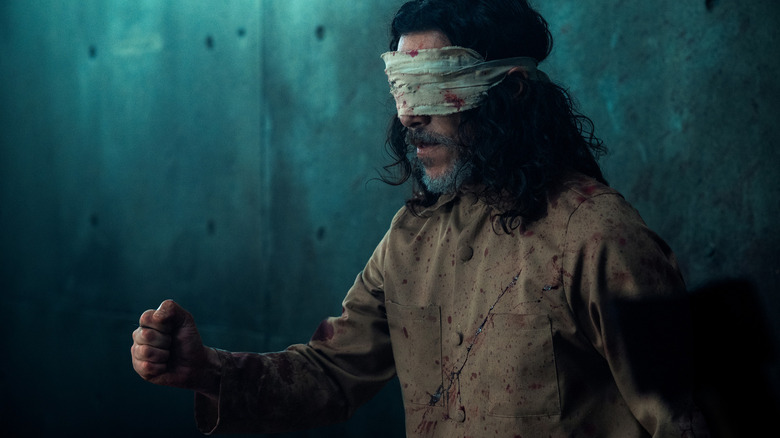How Trimagasi Is Still Alive
Spoilers for “The Platform 2” follow.
Both Galder Gaztelu-Urrutia’s “The Platform” and “The Platform 2” take place in the same futuristic prison, and abide by the same rules. The prison is a massive, narrow tower, hundreds of floors high. There is one cell on each floor, each occupied by two cellmates. A massive hole punctures through all the floors, and prisoners can look up and down at one another. Once a day, a floating platform covered with food floats down through all the cells, stopping briefly on each floor. Prisoners on the top can eat however much they like, but the prisoners below get their scraps.
In “The Platform 2,” unlike the first, the prisoners have instigated a strict code of behavior about the food. To make sure everyone is fed, they are all instructed — on the honor system — to take only a small amount of food earmarked for them. Those who abide by the rules have attached a religious-like intensity to their instructions, forming a cult-like mentality of mutual caring … or strict enforcement. Naturally, the true believers have to contend with other prisoners who have no regard for the rules and would rather look after themselves. Before the end of “The Platform 2,” many will die in bloody prison riots.
The protagonists from the first “Platform” film died, so “The Platform 2” follows a new protagonist, a woman named Perempuan (Milena Smit), an artist who was imprisoned for reasons she will make clear late in the film. She learns to live with the new rules, and dutifully eats only her share. Those who gave her instructions talk about how the new system was put in place by a mysterious Messiah-like figure, and the audience might assume, as I did, that one of the dead characters from the prequel founded it.
But then, late in the film, a previously dead character, Trimagasi (Zorion Eguileor), appears to Perempuan. The big twist? “The Platform 2” is not a sequel. It’s a prequel.
It’s not a sequel. It’s a prequel
Another wrinkle of the prison is that once a month, all the prisoners are tranquilized with gases, and then reassigned to new floors. If they were on the top before, they might find themselves way on the bottom the next month. No one is allowed to get used to their usual food supply. Late in “The Platform 2,” Perempuan awakens to find herself in the company of Trimagasi, a character who appeared at the beginning of the first “Platform” … and who died in that film. Trimagasi explains in “The Platform 2” that he just arrived and he needs the rules explained to him. In the first, he said that he had already been there for nine months.
The timeline, then, places “The Platform 2” about a year before the events of the first film. This means that the protagonist from “The Platform” didn’t instigate the new philosophy of kindness, nor was he responsible for unwittingly creating cults and factions inside the prison. Indeed, in the first “Platform,” there are no philosophies of caring, and all the prisoners must survive on their wits. This implies that the prison wasn’t improving after the events of the first film, trying out a new egalitarian society. Instead, it was deteriorating. “The Platform 2,” in being a prequel, showed that the prison once had a system that worked, but that system failed.
Trimagasi, shortly after he arrived, became swept up in an elaborate plan wherein Perempuan instigated a prison riot specifically so she could try to escape. Trimagasi was told to be as selfish as he wanted and eat all the food he needed. He does so happily. By the time we catch up with him in the first “Platform,” he is operating on bad intel, and spreading bleak survivalist rhetoric.
The stories for “The Platform” and “The Platform 2” are very, very similar, but with the revelation that the latter is a prequel, the story arc bending toward justice is inverted.




![Spider-Man’s Black Cat Joins The Avengers In New Marvel Comic [Exclusive Preview] Spider-Man’s Black Cat Joins The Avengers In New Marvel Comic [Exclusive Preview]](https://i2.wp.com/www.slashfilm.com/img/gallery/spider-mans-black-cat-joins-the-avengers-in-new-marvel-comic-exclusive-preview/l-intro-1735236299.jpg?w=1600&resize=1600,898&ssl=1)



![Spider-Man’s Black Cat Joins The Avengers In New Marvel Comic [Exclusive Preview] Spider-Man’s Black Cat Joins The Avengers In New Marvel Comic [Exclusive Preview]](https://i2.wp.com/www.slashfilm.com/img/gallery/spider-mans-black-cat-joins-the-avengers-in-new-marvel-comic-exclusive-preview/l-intro-1735236299.jpg?w=300&resize=300,300&ssl=1)







Post Comment